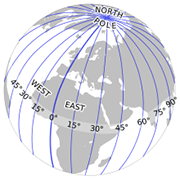E-Archive
Off the Beaten Track
in Vol. 17 - November Issue - Year 2016
A Matter Of Time

Longitude lines

Standard World Time Zones
The horse-drawn cab dropped him off in front of the train station well ahead of schedule. Tall, elegantly dressed in a two-piece suit and tie, he carefully positioned his hat as the driver handed him his luggage. He sauntered up the steps to the main hall, his briefcase in one hand and his suitcase in the other, his eyes darting over the three large timetables at the far end of the cavernous room. The importance of this railway junction was reflected in the fact that it was served by three different railroad companies. Each company had its own timetable, and above each timetable, there was a large round clock. The businessman did not find it strange that each clock marked a different time…
***
Before the advent of railroads and telecommunications, time had been kept pretty much the same way it had been kept for ages. Apparent solar time, often marked by a simple device such as a sundial, remained the basis for timekeeping even after mechanical clocks came into use. Regardless of whether one was in a large city or in a small village, noon was simply when the sun was directly overhead. The local population would set its clocks and pocket watches according to the town clock, which would be adjusted according to the position of the sun. People visiting a neighboring town would simply adjust their watches upon arrival. As long as most people never traveled far from home, this system served its purpose well enough.
All that changed with the railroad, which moved people quickly over great distances. There was confusion with train schedules, especially when passengers moved from east to west or vice versa. Train schedules were based on the local solar time of each community along the route, but this meant that clocks differed between places by an amount corresponding to the difference in their geographical longitude, which varied by four minutes of time for every degree of longitude. So, for example, if town A was five degrees west of town B, then when it was solar noon in town A, it would be twenty minutes past solar noon in town B. Every fifteen degrees of difference in longitude is equivalent to a one-hour difference in solar time.
This problem was especially felt in the United States and Canada, where transcontinental railroad lines extended for thousands of miles, mostly in an east to west direction. To complicate the problem even further, each of the several railroad companies published its own train schedules based on the local solar time of its headquarters. Train stations served by more than one railroad company had a clock for each company, each showing a different time.
The solution came with the creation of standard time, first adopted in 1847 in Great Britain by railways using portable chronometers synchronized with the Royal Observatory at Greenwich. Standard time accumulates small time differences into longer units, usually hours. This allows nearby communities to share the same time.
The Italian mathematician Quirico Filopanti was the first person to propose a worldwide system of time zones in his book Miranda! published in 1858. He suggested twenty-four hourly time zones, to be centered on the meridian of Rome. He also proposed a universal time to be used in astronomy and telegraphy.
Beginning in the late 1870s, Sir Sandford Fleming, a Canadian railway planner and engineer, presented his plan for worldwide time zones at several international conferences. He suggested the creation of twenty-four time zones, each occupying 15° longitude, with the prime meridian centered on Greenwich. At first his ideas encountered considerable resistance, given that the multitude of different timekeeping methods used by local communities the world over were deeply entrenched in tradition and history. Nevertheless, railway companies in North America adopted his proposal in 1883. A year later, he repeated his ideas at the International Meridian Conference, which did not endorse his time zones but that adopted a universal twenty-four hour day beginning at midnight in Greenwich, under the condition that it "shall not interfere with the use of local or standard time where desirable".
By the beginning of the twentieth century, almost all countries in the world had adopted standard time zones, although few used an hourly offset from Greenwich Mean Time (GMT) and preferred instead to base their standard time zone on the time observed at a local astronomical observatory.
Eventually everyone came around to using international time zones with hourly offsets from GMT, with the last country, Nepal, adopting theirs in 1986.
By Giovanni Gregorat, Contributing Editor MFN
Author: Giovanni Gregorat



























